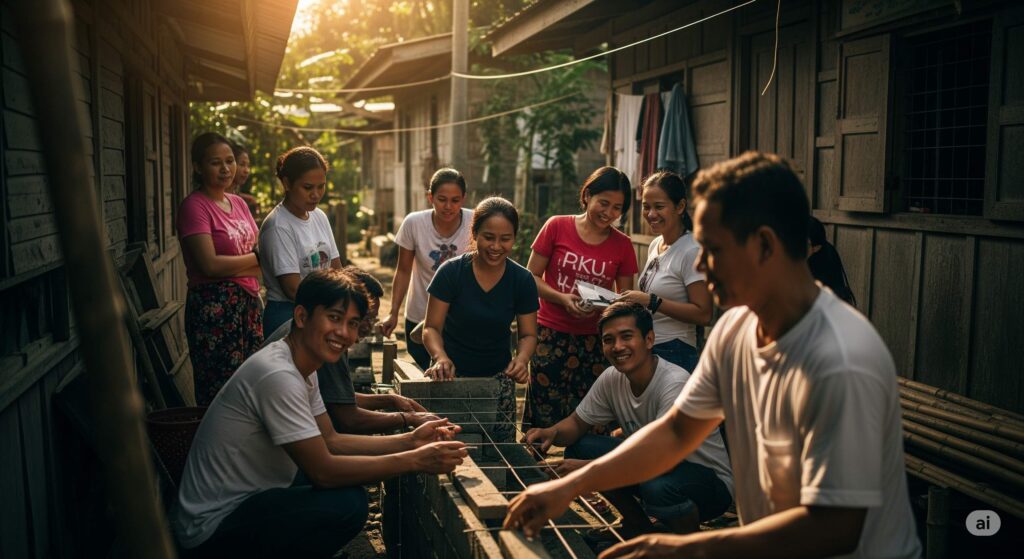Hey, solidarity superhero! Let’s uncover how you can team up with others to make your community thrive. Think of solidarity as a team sport —everyone has a role, and together you score big! Let’s find your position on the field.
Step 1: Icebreaker – What’s Your Solidarity Style?
🤝 Quick Quiz:
Which of these sounds like you?
- The Builder : “I love fixing things—like organizing tools for a community garden.”
- The Listener : “I’m great at hearing people’s stories and connecting them to help.”
- The Advocate : “I’ll march, write letters, or shout from rooftops for justice!”
- The Creative : “I use art or music to bring people together.”
(No wrong answers—your style is your strength!)
Step 2: Opportunities for Solidarity in Action
🌱 1. Address Basic Needs
- Food Security :
- Start/Join a community fridge or food drive.
- Volunteer at a soup kitchen.
- Housing :
- Support tenants’ rights groups fighting evictions.
- Help build tiny homes for unhoused neighbors.
🌍 Example : A neighborhood in Kenya created a “Hunger Solidarity Network ” where families share meals during droughts.
📚 2. Education & Skill-Sharing
- Tutor students struggling in school.
- Host free workshops (e.g., coding, gardening, résumé writing).
- Swap skills with elders (e.g., learn their traditional recipes; teach them tech basics).
💡 Activity: “Skill Swap Brainstorm”
What can you teach? What do you want to learn?
🌿 3. Environmental Justice
- Organize a tree-planting crew.
- Fight pollution by starting a “Plastic-Free Streets ” campaign.
- Support Indigenous land defenders.
🌍 Example : Youth in India formed “Trash Warriors ” to clean up mountains and rivers.
✊ 4. Social Justice & Rights
- Join protests against racism, sexism, or inequality.
- Fundraise for marginalized groups (e.g., LGBTQ+ shelters, migrant aid).
- Amplify voices from oppressed communities on social media.
🌍 Example : The Black Lives Matter movement built global solidarity by uniting millions to demand racial justice.
❤️ 5. Mental Health & Wellbeing
- Create a “Buddy System ” to check on isolated neighbors.
- Host free yoga or meditation sessions in the park.
- Share resources for affordable therapy.
🌍 Example : During lockdowns, communities in Spain formed “Balcony Support Groups ” to combat loneliness.
Step 3: How to Start – Your Solidarity Roadmap
1. 🕵️ Identify Needs
- Ask : What issues matter most in your community? (Pollution? Unemployment? Loneliness?)
- Listen : Attend town halls or chat with neighbors.
2. 🤝 Find Your Crew
- Join existing groups (e.g., Rotary Club, climate activists, faith-based orgs).
- Partner with schools, libraries, or local nonprofits.
3. 💪 Take Action (Big or Small)
- Micro-Actions : Share a meal, donate clothes, or write a thank-you note to a frontline worker.
- Macro-Actions : Launch a campaign, crowdfund for a cause, or run for local office.
Step 4: Overcome Challenges
⚠️ Common Hurdles & Fixes:
- “I’m too busy!” → Start small (e.g., 1 hour/month volunteering).
- “I don’t know where to begin!” → Google “[Your City] + volunteer opportunities” or ask friends.
- “I’m just one person!” → Remember: A single match can start a wildfire.
Step 5: Real Talk – Solidarity in Action
🌍 Case Study: The “Village Project”
In a low-income neighborhood:
- Residents formed a time bank (swap hours of help instead of money).
- Kids taught elders to use smartphones; elders taught kids to cook.
- Result: Stronger bonds and mutual respect!
❓ Reflect:
What’s one problem in your community that could be solved through solidarity?
Step 6: Your Solidarity Pledge
🚀 Homework Challenge:
- Today : Do one act of solidarity (e.g., share a resource, listen to a neighbor’s story).
- This Month : Join or start a group tackling an issue you care about.
💬 Final Thought:
“Solidarity is not a matter of altruism. Solidarity comes from the inability to tolerate that some people are made to count less than others.” – Judith Butler
You’ve got the tools—now go build solidarity! Remember: even superheroes need teams. Questions? I’m here! 😊


